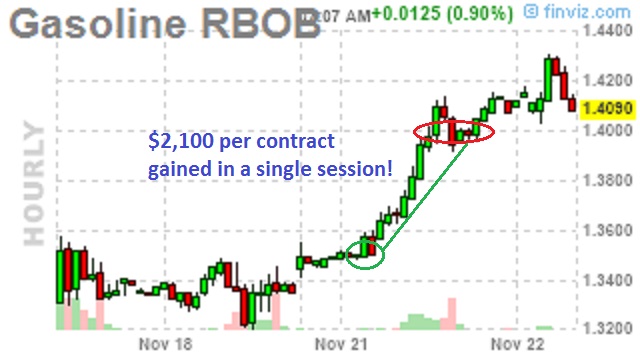 Yep, we did it again.
Yep, we did it again.
In yesterday's post, I noted that Gasoline Futures (/RB) were taking off, as they crossed the $1.35 mark and said our target was $1.45 and they already hit $1.40 during yesterday's session and it came so fast that we took the $2,100 profit per contract and ran, missing this morning's pop to $1.43 but hopefully we'll retest $1.40 for another entry (and another $2,100).
We're now into real profits on Gasoline Futures as we clawed back from our intitial loss with huge wins on Monday (+$1,875 per contract), Tuesday (+$1,875 per contract) and Thursday (+$420 per contract), where I said in Friday Morning's post: "Hopefully we'll pop over $1.35 (from $1.33) and run up from there.
We laid out our long premise for gasoline almost 3 weeks ago, right in the morning post:
http://www.philstockworld.com/2016/11/04/non-farm-friday-is-america-working-12/
So more people working making more money means more driving yet Gasoline Futures (/RB) have plunged to $1.39 this morning because that pipeline fire that caused prices to spike (which we shorted) earlier in the week, is already fixed but now we like /RB long because more workers = more drivers and we have the Thanksgiving Holiday coming up and that's a big demand holiday. We made a quick $500 yesterday on a pop off the $1.45 line so this, of course, is a much better entry but it's a scary, volatile contract that makes or loses $420 per penny move!
 It's those boring FUNDAMENTALS that make plays like this possible and the next Funamental Issue we're tracking is the very low volume that this "rally" has been trading on and that means there's no real support for this sudden $5 TRILLION surge in market valuation so, when people do finally decide it's time to take profits – there won't be any buyers and we can drop back very, Very, VERY fast.
It's those boring FUNDAMENTALS that make plays like this possible and the next Funamental Issue we're tracking is the very low volume that this "rally" has been trading on and that means there's no real support for this sudden $5 TRILLION surge in market valuation so, when people do finally decide it's time to take profits – there won't be any buyers and we can drop back very, Very, VERY fast.
How are we playing that? Well we talked about it yesterday, so let's move along. Early this morning I put out a new note for our Members with shorting lines for all of our futures plays, that was:
So I like these shorting lines at /ES 2,200, /YM 19,000, /NQ 4,875, /TF 1,325 and /NKD 18,200 – 3 of 5 rule applies, tight stops if any go back over so the rewards can outweigh the risk – NO BATHROOM BREAKS!
It's a very dangerous time to short the markets but we're fairly certain there's a lot more downside potential than upside to the market at this point. Electing Donald Trump President of the United States of America did not make all the World's problems go away and, frankly, with low unemployment – kicking out millions of people and "bringing back" millions of jobs would actually kick off a massive wave of inflation that would crush corporate profits.
Regardless of whether Trump's policies are ultimately good or bad, change is disruptive – it's not automatically good, which is what the market is anticipating. Also, a lot of the good consumer spending numbers we've been getting have been the result of lower oil prices and oil has jumped 15% since the election, which is a form of anti-stimulus.

Ultimately, that $1.5Bn comes off the bottom line of other retailers and it's more like $3Bn with mark-ups at the pump and, even worse, it makes the consumer think things are getting more expensive, which can be a self-fulfilling prophesy. As you can see from the chart above, it doesn't take much for inflation to begin to snowball and President Trump vows to cancel the Trans Pacific Partnership his first day in office – possibly sparking a trade war that will make everything more expensive.
The Agriculture ETF (DBA) has sugar, soybeans, coffee, corn, cattle, cocoa, hogs and wheat and makes a lovely play against food inflation. Let's say, for example, you spend $100 a week on groceries, call it $5,000 a year and you want to protect yourself against a move higher than $5,500. We could set up a trade like this:
- Buy 5 DBA 2018 $19 calls for $2.20 ($1,100)
- Sell 5 DBA 2018 $22 calls for 0.75 ($375)
- Sell 5 DBA 2019 $19 puts for 0.85 ($425)
That spread is net $300 and DBA is currently at $20.34 so your 5 contracts for 500 shares are worth $670 – DOUBLE what you're paying for the spread. The only way you will lose money on the spread is if food costs are more than 5% lower and that would save you $250 on your grocery bill to even out the $300 you paid for the spread – that's a good hedge!
Worst case is DBA goes below $19 and you are forced to buy 500 shares at $19 ($9,500) but, for each $500 DBA loses, your grocery bill offsets the loss by $250 and you would still be paying less than $5,000 for food while holding a permanent hedge against inflation (which you could then sell calls against for income).
If DBA goes back to $22, your $300 cash outlay returns $1,500 on just a 10% rise in food costs for a $1,200 gain (400%) – enough to cover a 25% rise in food costs.
A very good way to plan for next Thanksgiving!



